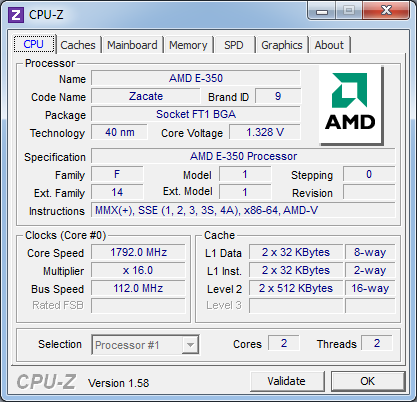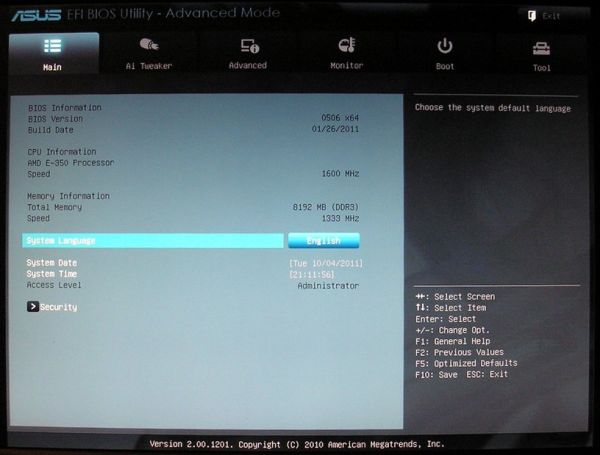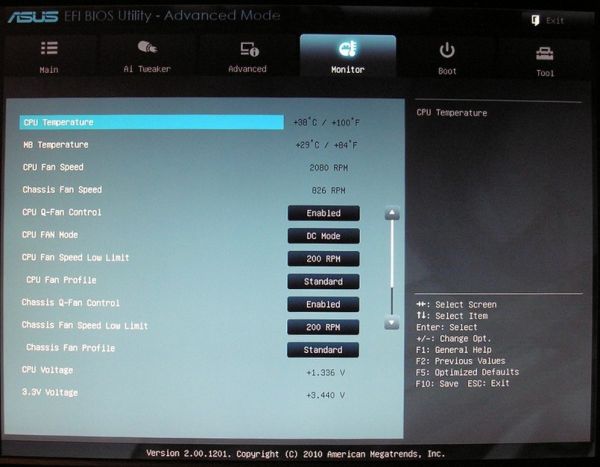ASUS E35M1-M Pro Review - Anyone For Fusion?
by Brendan van Varik on October 25, 2011 5:00 AM EST- Posted in
- Asus
- Motherboards
- Fusion
- E-350
BIOS
When you first enter BIOS, you will notice that ASUS have used a graphical BIOS with this motherboard. The BIOS itself is very easy to navigate through and when you get into it for the first time, you are faced with the ‘EZ Mode’ which shows you the basic things which a user may use or need to change such as the boot order of the system. When you enter the ‘Advanced Mode’, it opens up the entire BIOS so that you can turn things on or off which you would not find in the basic setup.
It is nice to see that overclocking features have been included in this BIOS but I do not think that many users will be buying this motherboard with overclocking in mind, as that will only raise power consumption and temperatures.
The fan controls in the BIOS allow you control both fan headers on the motherboard. You have a few options available which allow for either optimized cooling based on temperature, or if a quiet computing experience is preferred, that option is at your disposal too.
There are no noticeable changes between the release BIOS and the latest BIOS which is available on the ASUS website. ASUS claim improved system stability is achieved with the latest release although I have not experienced any issues on the shipped BIOS.
Overclocking
While overclocking may not be a strong point of this motherboard, it is still possible to squeeze a bit of extra performance out of the APU. I started with the ASUS Suite II software to see how good the automated overclocking was. The auto-overclocking feature added 3 MHz to the bus speed which increased the overall CPU speed by 48 MHz to give a final clock speed of 1648 MHz. The same overclock is applied if you select the AutoTune feature within the BIOS. It was stable but the increase in performance was not that noticeable.
Going through the BIOS, I was able to achieve a better result. The APU has a stock clock speed of 1.6 GHz and I was able to push it up to 1.792 GHz by using a 112 MHz base clock. All voltages were left on auto. When I went any higher than 112 MHz on the base clock, the motherboard would occasionally have an issue getting into Windows. However, from a stability standpoint, everything worked flawlessly at 112 MHz.

Along with standard stability tests, for completeness, the system was put under a 100 per cent loading for ten minutes and then the PC was put into a sleep state for the night. It switched on in the morning without any issues and full usability. When a 112 MHz base clock was used, there were no issues and the system was fully usable.


















66 Comments
View All Comments
hackztor - Tuesday, October 25, 2011 - link
I have the non pro version and after 2 months the nic died. I sent it in to asus repair and they said they repaired it and its still dead. Going to return it to newegg. The problem when the nic dies is their is only 1 slot on the non pro and that is used by my sata card stuff.ven - Wednesday, October 26, 2011 - link
Nobody is going to use a discrete graphics card with this board i don't know why all the manufactures uses x16PCIe slot.I was greatly surprised to see the presence of the slot for the first time before i came to known it was working in x4 mode.And also i don't think apart from video card there is no other PCIe card which extends that much length.mino - Wednesday, October 26, 2011 - link
Because it is really PCIe x4 slot and why not give you a full PCIe x16 instead of limiting user choices needlessly ? ...Mugur - Wednesday, October 26, 2011 - link
Nice review, but I was waiting for an E-450 review... :-) At least in Europe, there is an Asus model widely available.silverblue - Wednesday, October 26, 2011 - link
http://laptoping.com/amd-e-450-amd-radeon-hd-6320-...Death666Angel - Wednesday, October 26, 2011 - link
In one instance you talk about being "well within statistical variance", in another, you make it sound as though a .31 fps difference (which amounts to 1% deviation in this case) is grounds to separate the devices used.
Either you go all the way (and are wrong) and don't mention statistical variance and treat every result you have as being 100% perfect. Or you do take into account standard deviation and variance and don't make a 1% difference into an actual difference.
Otherwise, a good board and a good review. :-)
Though I still think a small Llano or a small Corei3 maintain the better package and don't really cost that much more. Cooling can be handled silently as well.
Daedalus454 - Wednesday, October 26, 2011 - link
I just upgraded my home server to this board last night. I'm running two Debian VMs on Xen. The E-350 is the fastest low-power system that I'm aware of which supports virtualization - AMD-V in this case. Atom based boards do not support VT-x. The extra slots on this particular board are nice as I need the PCIe x4 slot for my RAID controller, and this board gives me an extra x1 slot to add a second NIC if I need to do so in the future.The old system was a Brisbane Athlon 64 x2, I don't recall the speed. With the E-350 board performance is quite good. My VMs are running well and SMB transfers are quick.
The reason for my switch was that the old system pulled about 95 watts idle and 135 watts normal load and generated a lot of heat. That got uncomfortable since the server lives in my bedroom closet. The new system draws 65 watts full bore. Both systems include a Dell PERC5/i RAID controller and 3 1.5TB hard drives in RAID5. Xen doesn't seem to be very good about switching power states on this board however. I might need to adjust some settings on my Dom 0.
EVRE - Wednesday, October 26, 2011 - link
My friend who lives off the grid just build one of these.His setup:
Crucial 120gb m4 ssd
8gb of standard 1333 ram
sata dvd rw
DC DC 80w power supply from 12v corded brick (looks like an xbox 360's)
His idle power consumption is 16-17 watts at the wall with a Kill A Watt.
fluxtatic - Thursday, October 27, 2011 - link
For those who say go cheap on a SB system, consider that then you end up with some crap Biostar board. Here, you're getting an Asus (it seems to swing either direction, but they are one of the largest for a reason.) If you could build a comparable SB system on a decent board (Asus, Gigabyte, MSI), then maybe we're have a real debate. YMMV, but I would never recommend a cheap knockoff MB to save a few bucks on system like this.As to the x16 slot, I have come to the conclusion that it's a cost thing - a company like Asus is going to be buying the x16 slot connectors by the truckload, making the cost nothing. They're not going to get nearly as good a deal on open-ended x4-sized connectors, given that they would likely only be used on these Fusion boards (how often do you see dedicated x4 slots?)
I picked up a Sapphire Pure board in the spring, building a NAS/HTPC/server sort of thing...had I known that it wouldn't be done by now (waiting on the final finish for the scratch-built case), I would have waited...mine was $140, as I recall, was one of 2 that had 5 SATA ports. I almost bought this Asus, but it was a decent amount more then - $170 or so.
When it gets down to it, the Brazos platform outdoes Atom in everything but power consumption. If you look at Atom+Ion, they're closer, but Brazos still has a bit of an edge, and Ion brings the power consumption up to comparable levels, too. Face it - on this front, AMD finally has a winner. Cold comfort for those of us who waited (and waited) on BD, but there it is. Now I'm waiting for the Krishna core next year - I might just build two new boxes on that if AMD keeps up what they've done with Brazos so far.
Aries1470 - Thursday, October 27, 2011 - link
Hmm... I looked in the comments and also selected the print version too, it is shown in the picture of the back panel, it was even left out on page 3, board features.Why is that? I guess some people would still be interested in ieee-1394a.
It is also on the Asus' website:
http://www.asus.com/Motherboards/AMD_CPU_on_Board/...
one on the backpanel and one on the board too ;-)
Ok, end of rant :-)
Nice and informative article. Thank you.
Now to wait for the review of the Zotac ZBOX Mini-PC. This has the Via cpu, and is a great alternative to the Intel Atom too, and for Watt to Watt, might actually beat or be similar to this board.
Info on some of their Via Nano and Nano X2 boards here:
http://www.zotac.com/index.php?lang=un
Just search the site.
So Brendan, any idea when to expect an Atom vs Nano X2 vs AMD E or C series?